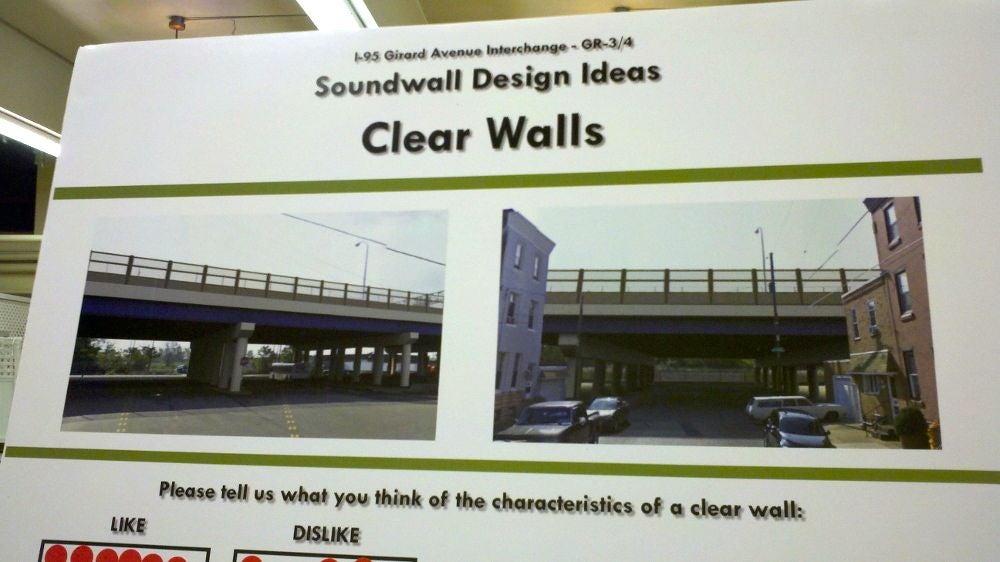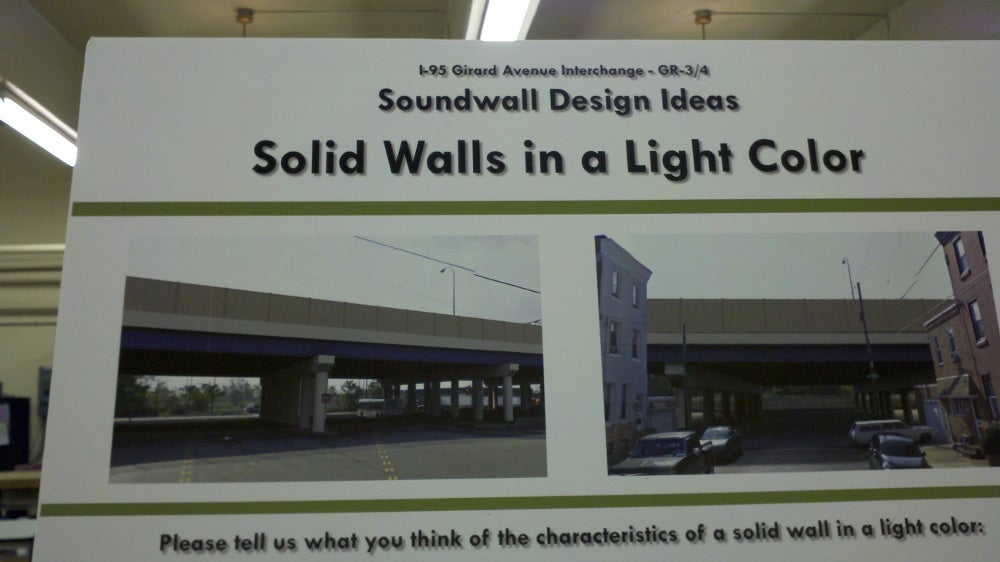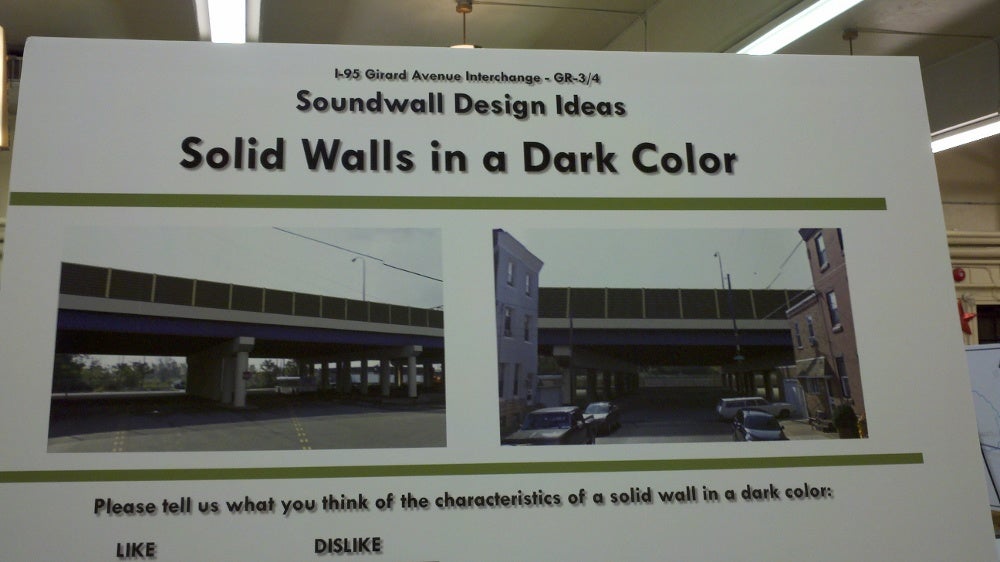Sound wall options given to property owners along I-95 construction corridor
On a mild night, Port Richmond resident Kathleen Briglio has a choice to make: Close the windows, or miss Jay Leno’s punchlines.
I-95 hovers over the edge of Briglio’s Salmon Street yard, and its the traffic noise that interferes with her TV watching and has been a near constant part of her family’s life since I-95 was built during the 1960s.
So Wednesday night, when PennDOT held a meeting to ask Briglio and her neighbors whether they wanted sound walls when the section of I-95 that runs through their neighborhood is rebuilt in a few years, she didn’t need time to think about her answer.
“We’ve been screaming for walls for years,” she said.
The meeting held at Mother of Divine Grace Church was the last in a series where representatives from PennDOT’s District 6 office and several consultants gathered owners of properties near I-95, from Old City to Port Richmond, for presentations on sound wall options. The first decision that everyone along the corridor was asked to make is a simple yes or no, said Project Manger Elaine Elbich.
Beyond yes or no, the soundwall question gets a bit more complicated: Should the walls be dark or light in color? Should they have patterns or be plain? Or, should they be made from a special clear plastic?
City planners and civic leaders from Northern Liberties have already told PennDOT that in some areas, they see a clear need for clear walls.
“City planning has had some concerns about the viewscape of the city from the highway,” said Chuck Davies, PennDOT’s engineer in charge of design at District 6. “The skyline is one of the city’s best advertisments, and they don’t want to close off that view.”
When asked about the desire for clear walls at the Delaware River Waterfront Corporation meeting Thursday, Planning Commission Chairman Alan Greenberger said he wasn’t in on planning’s detailed discussions, but the appeal of clear sound walls or no sound walls in some strategic areas was obvious. “One of the nice things about coming down the highway is the vistas of the city. It is exciting, and it builds a sense of anticipation that you are arriving in a big city,” he said.
Marian Hull, a consultant from URS Corporation who has been in charge of gathering stakeholder input for PennDOT, said that while there has been some interest in clear walls in other areas, it has been a hot topic in GR5 – the portion of the project that extends from Frankford Avenue south past the Ben Franklin Bridge and includes a slice of Fishtown, Northern Liberties and Old City. And it’s not just the city skyline to the west that people are concerned about, she said.
In Northern Liberties, the waterfront master plan calls for a view corridor on Spring Garden the whole way to the water, she said, so there is support for clear walls to the east.
Clear walls mitigate noise just as well as their solid counterparts, said consultant Harvey Knauer, vice president of Environmental Accoustics, at the meeting. It’s all about deflecting the noise – bending the soundwaves – and the different types of walls do it equally well, Knauer said.
Davies said they are more expensive, but he did not know exactly how much more. The biggest complication: While the walls are in use elsewhere in the country, PennDOT has not approved them for use in Pennsylvania.
So those working on the Revive 95 project are simultaneously seeking DOT approval and telling residents about the possibility of using them, Hull said.
There is some time for all sections, and a good deal of time for the GR5 section where the interest seems strong, she said. The next phase slated for work to begin is GR2, which runs from Shackamaxon to Columbia in Fishtown, and construction won’t start until fall 2012. GR5 won’t happen until 2017.
Speaking of GR2 in Fishtown, because that section is next on the construction schedule, design work is further along. The soundwall votes of property owners there have already been tallied. The answer was yes, Elbich said. Because more public input sessions on design have already been held, residents in that area also voted on which type of wall they want. Those votes haven’t been tallied, Elbich said.
Briglio and others whose properties sit along the northern portion of phases GR3 and GR4, have until Nov. 5 to vote for or against sound walls. Voting is also still open for the southern portion of GR3 and GR4, and for GR5, Elbich said. Documents can be found here.
Outside of GR2, property owners in any area who vote in favor of soundwalls won’t take an official vote on the specific sound wall design they want until sometime in the future – probably next year for the roughly 50 people at Wednesday’s meeting.
But they have been asked for general preferences. Hull went over the pros and cons of the various types.
Whether dark, light, patterned or plain, a solid wall hides most vehicles and their lights from neighborhood residents, Hull said. But they also can cast a shadow on some homes and yards – something Elbich said gardeners from other areas were concerned about.
Dark walls hide dirt best, Hull said. They also tend to blend into the background. Light walls and patterned walls stand out more – and this can be advantages when residents want to highlight a certain part of their neighborhood.
In addition to allowing highway drivers to enjoy special views, clear walls do not cast shadows on homes or deprive gardens of sunlight, Hull said. Sometimes, people with homes near I-95 have views of the river or other sights that would be blocked by a solid wall, she said.
Clear walls do not block headlights, however. They are sturdy, but not quite as sturdy as solid walls, Hull said. PennDOT would order clear walls with cables inside, which would both hold the wall together if part of it broke and make the walls visible to birds, reducing collisions.
If anyone tags a clear wall, it will take a special cleaner to remove the graffiti, Hull said. “For solid walls, the cleaner is called paint.”
Briglio prefers a dark, solid wall for her neighborhood. Because the highway is elevated in this section, no light would be lost, she said. She doesn’t care to see the cars, or imagine drivers really care to see her house and her neighbors’, either.
Reach the reporter at kgates@planphilly.com
WHYY is your source for fact-based, in-depth journalism and information. As a nonprofit organization, we rely on financial support from readers like you. Please give today.






